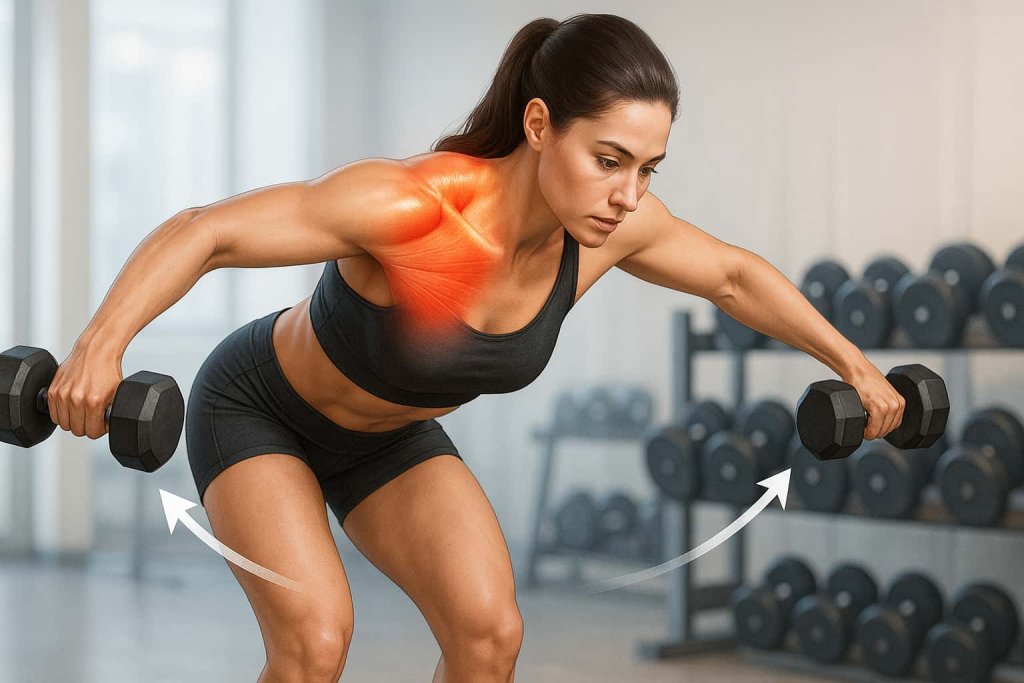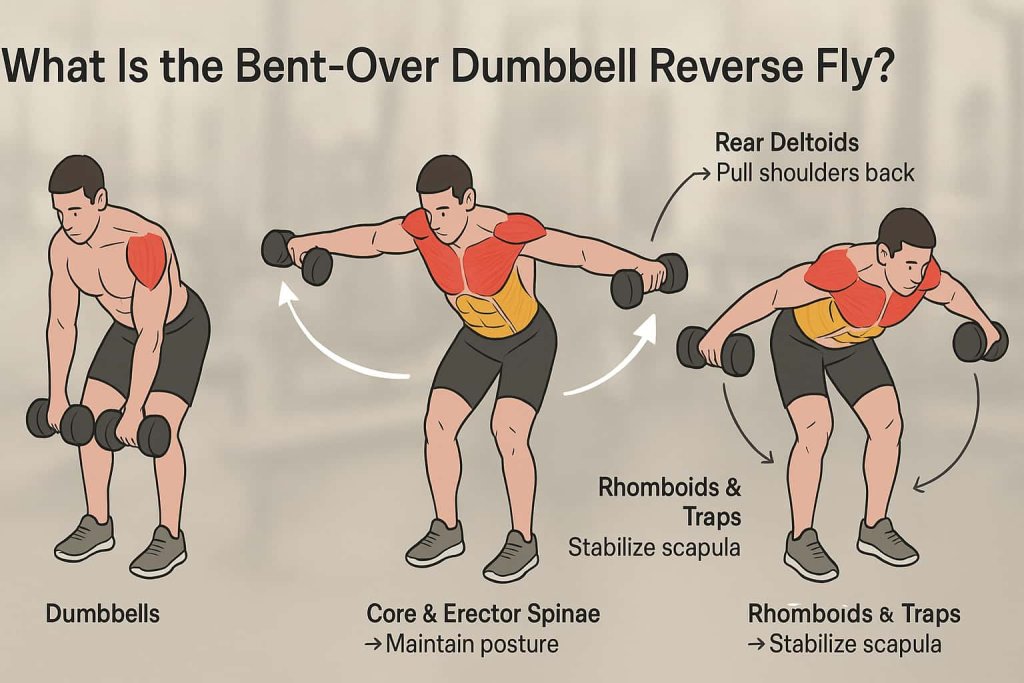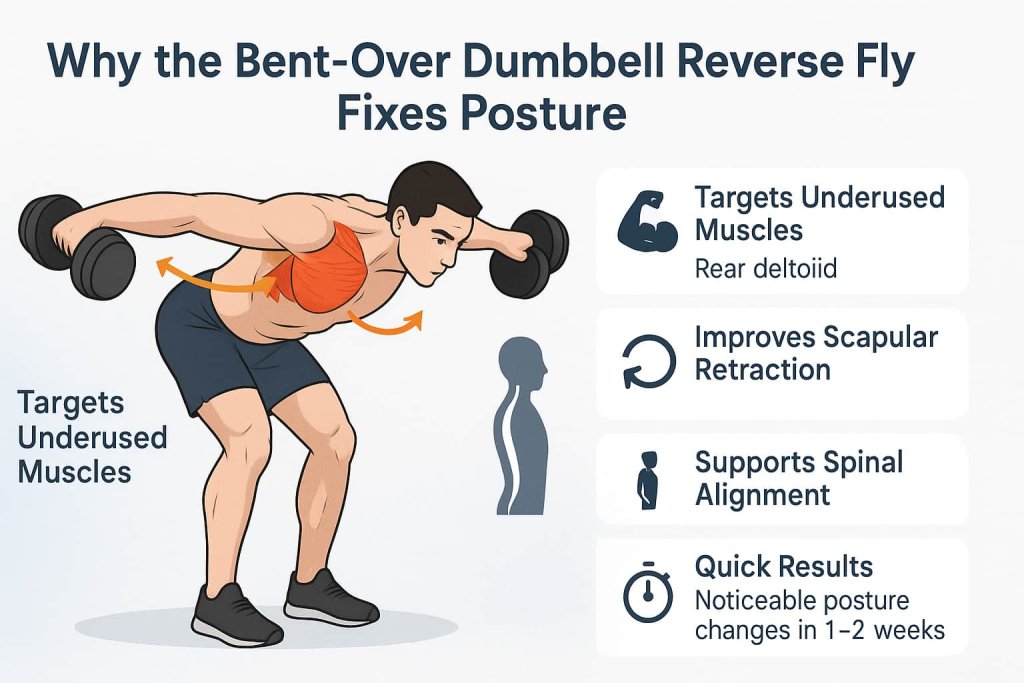Yes, the bent-over dumbbell reverse fly can noticeably improve posture within 2 weeks if performed consistently with proper form. This exercise strengthens the rear deltoids, rhomboids, and trapezius—muscles that counteract slouching and rounded shoulders.

For anyone sitting long hours at a desk or struggling with poor posture, this move is a game-changer. It directly targets weak postural muscles, enhances shoulder stability, and supports spinal alignment. With just a few sets added to your routine, you can stand taller, reduce discomfort, and feel stronger.
What Is the Bent-Over Dumbbell Reverse Fly?
The bent-over dumbbell reverse fly is a resistance exercise where you hinge forward at the hips, hold dumbbells with a neutral grip, and lift your arms laterally until they are in line with your shoulders.

Primary Muscles Worked:
- Rear deltoids (back of shoulders)
- Rhomboids (between shoulder blades)
- Middle and lower trapezius
Secondary Muscles:
- Erector spinae (for posture support)
- Core stabilizers
- Forearms
By strengthening these muscles, the exercise helps pull your shoulders back into alignment, improving posture and reducing the “rounded shoulder” look.
Why the Bent-Over Dumbbell Reverse Fly Fixes Posture

- Targets Underused Muscles → Most daily activities (typing, texting) overwork the chest and front delts while neglecting the rear delts. This exercise restores balance.
- Improves Scapular Retraction → Strong rhomboids and traps stabilize the shoulder blades, preventing slouching.
- Supports Spinal Alignment → A stronger upper back reduces forward head posture and neck strain.
- Quick Results → A Tom’s Guide experiment (2024) showed visible posture improvements in just 7 days of daily reverse fly training.
How to Do the Bent-Over Dumbbell Reverse Fly (Step-by-Step)
- Start Position:
- Hold a dumbbell in each hand with palms facing each other.
- Hinge forward at the hips until your torso is nearly parallel to the ground.
- Keep a slight bend in the knees and elbows.
- Execution:
- With control, raise your arms out to the sides until they reach shoulder height.
- Squeeze your shoulder blades together at the top.
- Return:
- Slowly lower the weights back to the starting position.
Trainer Tip: Avoid swinging. If you can’t control the weight, go lighter to maximize posture benefits.
Common Mistakes to Avoid in the Bent-Over Dumbbell Reverse Fly
Even a great posture exercise can lose its effectiveness if done incorrectly. Watch out for these pitfalls:
- Using too much weight → causes momentum instead of muscle activation.
- Not hinging forward enough → reduces rear delt engagement.
- Shrugging shoulders → over-activates traps instead of rear delts.
- Moving too fast → eliminates time under tension.
- Arching or rounding the lower back → increases risk of injury.
👉 Keep the movement slow, controlled, and deliberate for best posture correction.
Variations of the Bent-Over Reverse Fly
1. Seated Reverse Fly
Why it works:
Sitting on a bench and hinging forward reduces strain on the lower back compared to the standing version. This makes it beginner-friendly while still effectively targeting the rear deltoids and upper back.
How to do it:
- Sit on the edge of a flat bench with dumbbells in each hand.
- Keep feet flat on the floor, hinge forward at the hips until chest is close to thighs.
- With a slight bend in elbows, lift arms outward in a wide arc until parallel to the floor.
- Slowly return to starting position.
Muscles worked: Rear delts (primary), rhomboids, traps.
Trainer Tip: Keep core braced and avoid rounding the upper back. Focus on slow, controlled movement—don’t let momentum take over.
2. Chest-Supported Dumbbell Reverse Fly
Why it works:
Performed lying face-down on an incline bench, this variation removes momentum and isolates the rear delts. It’s great for strict form and protecting the lower back.
How to do it:
- Set an incline bench at about 30–45 degrees.
- Lie chest-down with dumbbells hanging directly under shoulders.
- Raise arms outward in a reverse fly motion until parallel to the ground.
- Lower under control.
Muscles worked: Rear delts (primary), traps, rhomboids.
Trainer Tip: Don’t lift too heavy—focus on quality reps with full range of motion. Squeeze shoulder blades at the top for maximum activation.
3. Single-Arm Supported Reverse Fly
Why it works:
By bracing one hand against a rack, bench, or knee, you stabilize your torso. This allows heavier loading with better control, making it excellent for strength progression and fixing imbalances.
How to do it:
- Hold a dumbbell in one hand.
- Place the opposite hand on a bench or rack for support.
- Bend slightly at the hips and keep spine neutral.
- Perform the reverse fly with the working arm, lifting out to the side.
- Slowly lower and repeat, then switch sides.
Muscles worked: Rear delts, traps, rhomboids, with added core engagement for anti-rotation.
Trainer Tip: Exhale as you lift. Avoid twisting your torso—keep chest square to the ground for true isolation.
Programming for Posture Correction
- Frequency: 2–3 times per week
- Sets/Reps: 3–4 sets of 12–15 reps
- Progression: Increase weight by 5–10% when 15 reps feel easy
- Rest: 45–60 seconds between sets
Tip: Pair with chest stretches to balance anterior and posterior muscles for even faster posture improvements.
Who Should Do the Bent-Over Dumbbell Reverse Fly?
This exercise isn’t just for bodybuilders—it benefits almost everyone:
- Office workers → counters hours of sitting and slouching.
- Athletes → improves scapular stability for better throws, swings, and lifts.
- Weightlifters → balances pressing movements by strengthening rear delts.
- Older adults → safe, low-impact way to build posture muscles.
- Anyone with rounded shoulders → directly addresses muscular imbalance.
Benefits Beyond Posture
- Reduced Neck & Shoulder Pain: Strengthens stabilizers that reduce strain.
- Better Shoulder Health: Prevents impingement by improving scapular movement.
- Enhanced Athletic Performance: Supports overhead lifts, throws, and pulling strength.
- Aesthetic Gains: Adds width and definition to the upper back.
FAQ: Bent-Over Dumbbell Reverse Fly
1. How soon can I see posture improvements?
Most people feel differences in muscle activation within 1 week and notice visible posture improvements in 2–3 weeks with consistency.
2. Can beginners do this exercise?
Yes, start with light dumbbells (2–5 lbs) or resistance bands to master form.
3. Should I keep my arms straight or bent?
Keep a slight bend (10–15°) in the elbows to protect joints.
4. Is it safe for people with back pain?
Yes, but use the chest-supported version to avoid stress on the lower back.
5. How much weight should I lift?
Choose a weight you can control for 12–15 reps without swinging. Form matters more than heavy load.
6. Can I replace this with rows?
No. Rows mainly target lats, while reverse fly emphasizes rear delts and posture muscles.
7. Do I need gym equipment?
No. Bands and even household items like water bottles can substitute dumbbells.
Conclusion
The bent-over dumbbell reverse fly is one of the simplest yet most effective exercises for posture correction. Within 2 weeks of consistent practice, you’ll feel stronger, stand taller, and experience reduced upper back tension.
👉 Start adding 3 sets to your workouts twice a week, and combine with stretching for maximum posture gains.
Take action today—your future self will thank you every time you look in the mirror or sit comfortably without slouching.
References
- Schoenfeld, B. J., et al. (2013). Effect of hand position on EMG activity of the posterior shoulder musculature during a horizontal abduction exercise. Journal of Strength and Conditioning Research, 27(10), 2644–2649.
- Bergquist, R., Iversen, V. M., Mork, P. J., & Fimland, M. S. (2018). Muscle activity in upper-body single-joint resistance exercises with elastic bands vs. dumbbells. Journal of Human Kinetics, 61, 5–13.
- American Council on Exercise (ACE). (2014). Dynamite Delts: ACE Research Identifies Top Shoulder Exercises.
- Nitayarak, H., et al. (2021). Effects of scapular stabilization exercises on posture and muscle function. Journal of Physical Therapy Science.
- Abd El-Azeim, A. S., et al. (2022). Impact of adding scapular stabilization to postural-correction exercises in symptomatic forward-head posture: A randomized controlled trial. Journal of Musculoskeletal Science and Practice.
